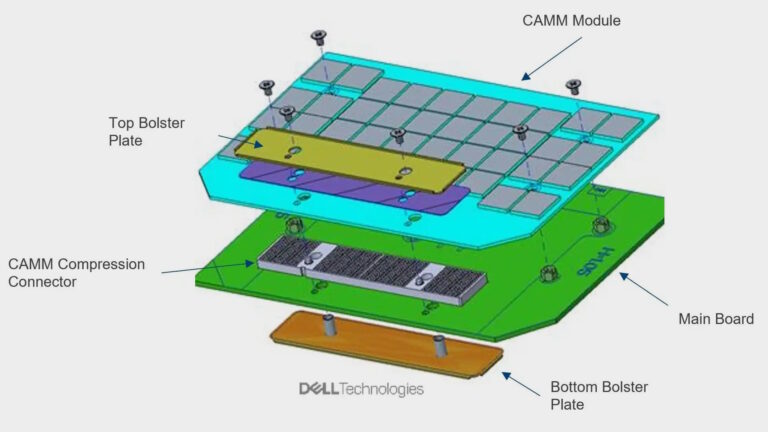Introduction
The tech industry is witnessing the rise of a new memory module standard known as CAMM2, which stands as a promising alternative to the prevalent SO-DIMM sticks in today’s laptops. The allure of CAMM2 lies in its slimmer profile, offering the same level of replaceability as its predecessors but with a reduced thickness. This innovation is not only expected to revolutionize the laptop market in the coming years but also shows potential for integration into desktop PCs, marking a significant shift in memory module design and application.
CES Discussion on CAMM2
At the recent CES event, conversations with SK Hynix, a leading memory manufacturer, revealed insights into the future of CAMM2. The company confirmed that the new memory standard is set to be adopted not only in laptops but in desktops as well. This information was initially brought to light by Korean outlet ITSub and further spotted by harukaze5719 on Twitter.
SK Hynix confirms CAMM2 will be adopted in laptops and desktops, as per CES discussions.
— harukaze5719 @harukaze5719.twitter.com (@harukaze5719)
Date
While the exact nature of desktop integration remains open to interpretation, it’s clear that CAMM2’s versatility is being considered for various form factors, including compact NUC-like designs.
JEDEC’s Statement on CAMM2
In a recent press release, JEDEC, the global leader in developing open standards for the microelectronics industry, shed light on the intended use cases for DDR5 and LPDDR5/5X CAMM2s. The organization outlined the distinct applications for each, emphasizing the compatibility of CAMM2 with both DDR5 and LPDDR5 memory types.
| DDR5 CAMM2 | LPDDR5/5X CAMM2 |
|---|---|
| Targeted for performance notebooks and mainstream desktops | Designed for a broader range of notebooks and certain server market segments |
JEDEC also highlighted the importance of different pinouts and mounting designs for each memory option to prevent incorrect module installation.
Benefits of CAMM Modules
CAMM modules offer a transformative approach to memory design, particularly for laptops. Their flat, single-PCB structure allows for a significant reduction in Z-height, making them an ideal replacement for bulkier SO-DIMMs. Here are some of the advantages of CAMM over traditional memory modules:
- Reduced thickness for slimmer laptop designs
- Removable format for easy upgrades and replacements
- Support for both DDR5 and LPDDR5 memory types
- Potential for greater modularity and capacity with stackable options
Moreover, CAMM’s design facilitates easier cooling compared to vertical DIMMs, which could be particularly beneficial for compact systems.
Potential for CAMM in Desktop PCs
The potential adoption of CAMM modules in desktop PCs could bring about a host of benefits, particularly for Mini-ITX boards where space is at a premium. The flat design of CAMM could lead to more efficient use of space and even allow for better cooling solutions, as memory modules could be cooled more effectively in a horizontal orientation.
However, the transition to CAMM in desktops is not without its challenges. One of the primary considerations is the balance between innovation and cost. Memory DIMMs have been a reliable and affordable solution for many years, and any new technology will need to demonstrate clear advantages without significantly increasing the price for consumers.
JEDEC’s involvement suggests that there is industry-wide interest in exploring the possibilities of CAMM. The modularity offered by stackable CAMM modules could also lead to increased memory capacities, which would be particularly beneficial in compact systems like Mini-ITX boards.
Ultimately, the future of CAMM in desktops will likely depend on its initial reception in laptops. If CAMM can prove its value in the laptop market, it may pave the way for broader adoption in desktop PCs, offering users the benefits of a more modular, efficient, and potentially more powerful memory solution.


